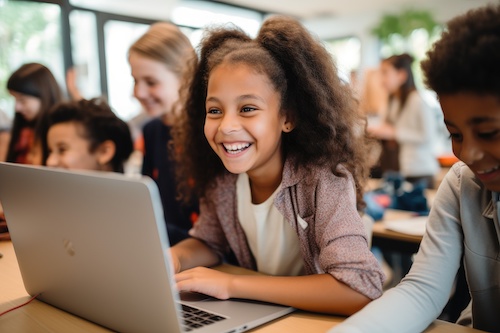Key points:
In the year and half since the launch of ChatGPT, AI-powered edtech tools have flooded the market–but most, if not all, of these products may be missing out on the most exciting and creative ways to use AI in the classroom.
While 89 percent of teachers reported in a recent survey that they believe generative AI will have an impact on teaching, recent reporting in the Wall Street Journal and The74 have rightly identified some of AI’s limitations in education, questioning the technology’s ability to serve as, for example, an effective tutor. But is asking generative AI to do math or engage students in a tutoring relationship really the best way to use this incredibly powerful technology? We are overlooking simpler but more effective ways to use AI in the classroom.
As an edtech researcher and designer who has spent the last 15 years studying how technology can bridge the gap between learning and play, I’m struck by the ways in which generative AI can bring creativity and playfulness to the classroom–a notion that I know runs counter to some of the current critiques.
Amplifying creativity and collaboration with AI
My former colleague and MIT professor Mitch Resnick bemoans the current uses of AI in education, which aim to replicate conventional teaching methods by focusing on problems that have a right answer. For example, answers provided by generative AI chatbots can sometimes be misleading when it comes to subjects like math, where a student’s solution to a problem is either right or wrong. “AskingChatGPT to do math is sort of like asking a goldfish to ride a bicycle–it’s just not what ChatGPT is for,” observed Yale professor Tom McCoy.
Instead of replicating current instructional methods and tasks, there’s tremendous potential to leverage generative AI in scenarios where students can creatively solve meaningful problems that don’t have a known answer. Zenny Ulloa, a curriculum support specialist at Miami-Dade County public schools, told me at ISTELive 24 that part of this creative learning process should require students to explain how they used ChatGPT or other AI tools. For instance, instead of banning tools like ChatGPT for essay writing, teachers can encourage students to use AI in their work but clearly document how their essays evolved through multiple drafts. Students then engage in “intelligence augmentation,” or the enhancement of human intelligence through AI tools.
Resnick calls for more opportunities for students to collaborate by using AI systems to support real-world team-based projects. This might happen, for example, when students work together as a team but ask AI questions to jumpstart their own brainstorming on a topic. Then, students can evaluate the AI tool’s suggestions and bounce ideas off one another to build on AI’s suggestions. In this type of exercise, AI provides a scaffolding for student collaboration–not a replacement.
When used creatively and collaboratively, AI can help students learn more than just facts. It can teach them important skills for the future, like working well with others and using new technologies effectively.
The next generation of playful learning
A creative and collaborative approach to AI aligns with “playful learning” teaching methods, in which learners are allowed to explore, experiment, be curious, and try new things in a low-stakes environment. Research shows that playful learning helps students work together and share ideas more effectively. Using AI playfully in the classrooms helps students construct an understanding of the technology while they build soft skills.
So what might playful learning with AI tools look like in practice? For one, it can involve students getting hands-on with AI. In my graduate-level education course, I gave students the opportunity to create their own AI applications and test them out with teachers or learners. Students used the PlayLab platform to experiment with and iterate on their ideas, with projects like an inquiry-based guessing game for students and a tool to make lessons more culturally relevant for teachers. By building new tools with AI, rather than using existing AI tools, my students had a deeper learning experience, enhancing their understanding of not only what AI can do, but also what teaching and learning mean to them.
Future-ready learning through playful AI
Imagine a history class where students use AI to generate images of historical figures or events, then work together to analyze the accuracy and biases in these depictions. Or a science class where AI helps students visualize complex molecular structures, allowing them to manipulate and explore these models in ways previously impossible. These examples show how AI can enhance learning experiences, making them more engaging and interactive.
While the AI-powered features already built into edtech tools are certainly useful, they often mask the AI technology behind an interface and focus on product over process. A more hands-on approach would allow students to experiment directly with AI, learning through trial and error. For example, students could try to “outsmart” AI by finding creative ways to ask questions that challenge its limitations, thereby gaining a deeper understanding of both the technology’s capabilities–and flaws.
While it’s challenging to change how teachers think about education, this playful approach is part of a much needed rethinking of what education should be and how it can best prepare students for a rapidly-changing future. The combination of playful learning and AI tools has the potential to empower learners and build future-ready skills, putting them in charge of their own learning now and throughout their lives. Let’s get creative instead of focusing on the conventional.


